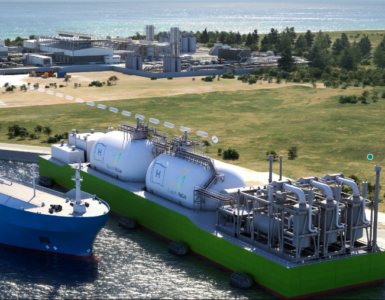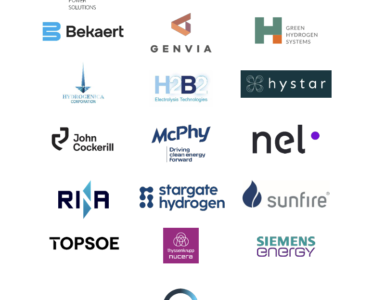Inside the rapid rise of the clean hydrogen economy – Bill Newsom, President and CEO Mitsubishi Power Americas.
Any engineer will tell you that the best solution to a problem is typically the simplest one. We can apply this thinking to the energy transition. Most of the carbon emissions we generate are from using fossilized hydrocarbons for fuel. Therefore it stands to reason that hydrogen, the simplest and most abundant element in our known universe, has a key role to play. Hydrogen can be both a zero-carbon fuel and long duration storage of renewable energy.
As is often the case, what’s simple isn’t always straightforward. Although electrolysis—the process of breaking water molecules into hydrogen and oxygen gases—is well understood, we need to scale up the amount of clean hydrogen in order to increase adoption and ultimately make it more economical. Producing clean hydrogen in this way, storing it, transporting it, and using it at scale are challenges that still need solving, and quickly.
The good news is, over the past two decades, the power industry has removed approximately 38% of the carbon emissions simply by replacing coal-fired power generation with natural gas-fired power generation and renewables, such as wind and solar. There is still more work to be done. Recent legislation, such as the Infrastructure Investment and Jobs Act (IIJA) and the Inflation Reduction Act (IRA) are going to be the catalysts to accelerate the pace of the energy transition.
In my recent CERAWeek panel with Andy Marsh of Plug Power, Justin Bird of Sempra Infrastructure, Andrew Flanagan of RWE Renewables Americas, and S&P Global’s Eleonor Kramarz, we discussed the major role hydrogen will play in a net zero world, how quickly and dramatically the element could transform energy value chains, and what we can learn from the past. Here are my key takeaways from our conversation:
Hydrogen Will Accelerate The Energy Transition
The faster we develop a thriving market for clean hydrogen, the faster we can accelerate progress toward carbon emission reduction goals. In the near-term, hydrogen has a key role to play in decreasing carbon emissions because it functions both as a fuel and, more importantly, as a form of renewable energy storage.
In regions such as the Western United States, there are more renewables than we need at certain times of the day, resulting in curtailed energy production. Coupling the excess renewables with electrolysis to produce green hydrogen can enable storing the renewable energy for days, weeks, months, or even seasons.
This creates a zero-carbon fuel source that can be re-electrified when power demand is high or used for hard-to-abate sectors such as steel manufacturing, ammonia production, and long-haul transportation. Add in investment tax credits and production tax credits as introduced by the IRA, and we can accelerate the pace at which we scale hydrogen production to make it readily available and cost-effective.
We have partnered with Magnum Development to invest in such infrastructure. The Advanced Clean Energy Storage Hydrogen Hub in Delta, Utah is a utility-scale hydrogen production and salt cavern storage hub. The hub will initially have two underground salt caverns, each one the size of the Empire State Building, and will hold a total of 9 million barrels of green hydrogen.
The hydrogen produced will be used at the neighboring Intermountain Power Plant to fuel two M501JAC gas turbines using 30 percent green hydrogen at start up in 2025 and transitioning to 100 percent green hydrogen by 2045. The ACES Delta Hub is backed by a $504 million dollar Department of Energy loan.
The ability to harness excess power generated by renewable sources has the potential to improve the economics of renewable power generation in the near-term by allowing renewables to run at higher capacity factors. Geologic storage provides a long-term storage solution that battery technology has yet to find.
Learning From The Past
When we look back over the past three decades, as an industry, we have made great strides toward reducing our carbon emissions and can apply those learnings to the work we are doing today to reach net zero. For example, the first wind power PTC was enacted in 1992 and has been extended and modified in the years since.
This tax credit made wind power generation a cost-effective and viable option and spurred year-over-year growth with a total installed capacity of 139,635 MW as of Q3 of 2022. Not only was there exponential growth of wind, but the price of onshore wind energy declined 70 percent between 2009 and 2019. Today, we see hydrogen at a similar inflection point.
Maximizing the early investments in clean hydrogen production depends on growing clean hydrogen’s supply and demand in tandem. The IRA’s landmark legislation is driving a competitive supply scenario that over time, will drive down costs, and increase demand for clean hydrogen across multiple sectors. Additionally, the ability to stack credits provides a distinct advantage to green and blue hydrogen development.
Efficient Use of Existing Infrastructure
Improving the economics of clean hydrogen through public and private partnerships will accelerate the clean hydrogen economy by decarbonizing existing assets. For example, Mitsubishi Power, in partnership with Georgia Power, Southern Company, and EPRI recently demonstrated the use of a 20 percent hydrogen blend in an M501G advanced class gas turbine at McDonough-Atkinson in Georgia, illuminating a path for power producers to incorporate hydrogen-fueled production with currently available equipment.
Keeping an eye on the quickest implementation paths for clean hydrogen technologies will be another key factor in scaling both supply and demand sustainably.
A Functioning Hydrogen Value Chain Requires Collaboration
It will require extraordinary collaboration among many partners, both public and private, for clean hydrogen to reach its full potential. Over the medium term, we can continue to adapt existing infrastructure, build new infrastructure, and innovate for the next generation of technologies to keep pace with the energy transition.
Reinventing a hydrocarbon-based society that was more than 100 years in the making with low- or no-carbon solutions in less than 30 years is the greatest challenge of our times. But it’s a challenge I’m convinced we can tackle, together.
Inside the Rapid Rise of the Clean Hydrogen Economy, March 7, 2023









